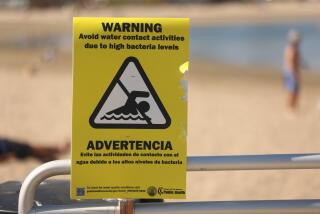Raise Fees, Inspect More Pools : The absurdity of failing to monitor the public health
- Share via
Southern California has come to be known as the land of swimming pools; the image calls to mind crystal clear, elliptical back-yard pools with water glistening under year-round sunshine.
In fact, the sun doesn’t always shine here, and lots of pools in Los Angeles County contain anything but glistening clear water. Too many have become so-called “dark” pools, overgrown with algae that spreads over the surface like a blanket of muck. Bacteria breed there, setting up the potential for widespread infection and increasing the chances of drownings.
Such conditions persist because there are not enough inspectors. The county, which is in charge of inspecting its 16,700 public pools and spas, has only eight people to do the job. That’s the same number the county had 20 years ago, when there were half as many pools in parks, schools, hotels, health clubs, apartments and condominiums.
Times writer Tracey Kaplan reported that 41% of the pools in the county have not been inspected for at least three years; almost 5,000 pools have not been inspected for at least four years.
Contrast that dismal record with Orange County, where each of its 6,400 public pools and spas were inspected three times last year.
The main difference between the Los Angeles inspection program and Orange County’s? Money. Pool operators in both counties pay an annual fee for inspections. Los Angeles’ fees just went up this year to $104. Orange County charges a fee of $179. So Orange County--with less than half the number of pools and spas--has six times the number of inspectors, 48, as does Los Angeles County.
Los Angeles health officials have asked for more inspectors, but the Board of Supervisors has been reluctant to further raise the fees paid by pool operators who would pay the increased costs.
But considering the major problems invited by poor upkeep of pools--widespread parasitic illness, eye infections, drownings and lawsuits--county public pool operators can either pay a few dollars now for prevention or pay big later. The board should opt for prevention.
More to Read
Sign up for Essential California
The most important California stories and recommendations in your inbox every morning.
You may occasionally receive promotional content from the Los Angeles Times.










